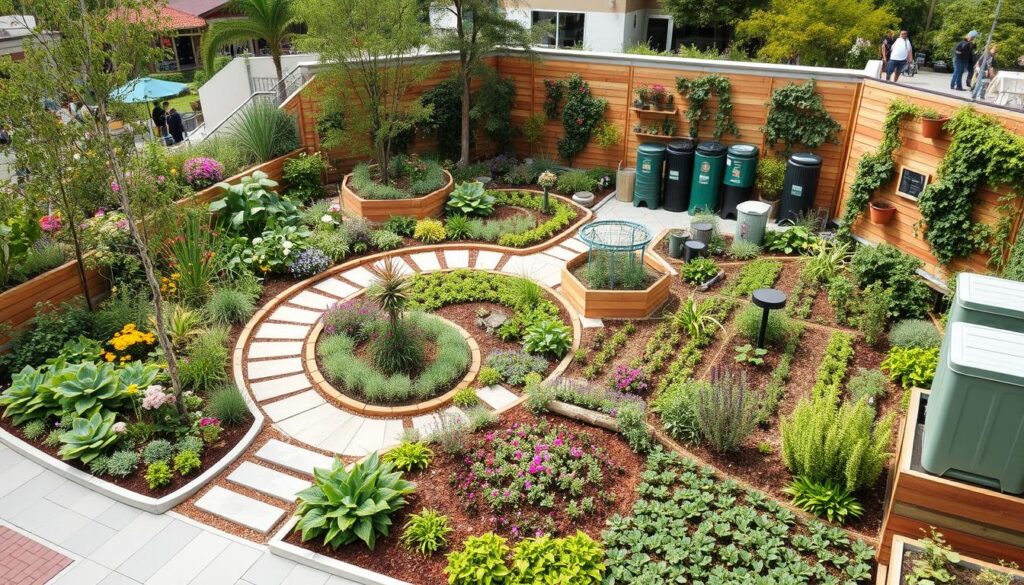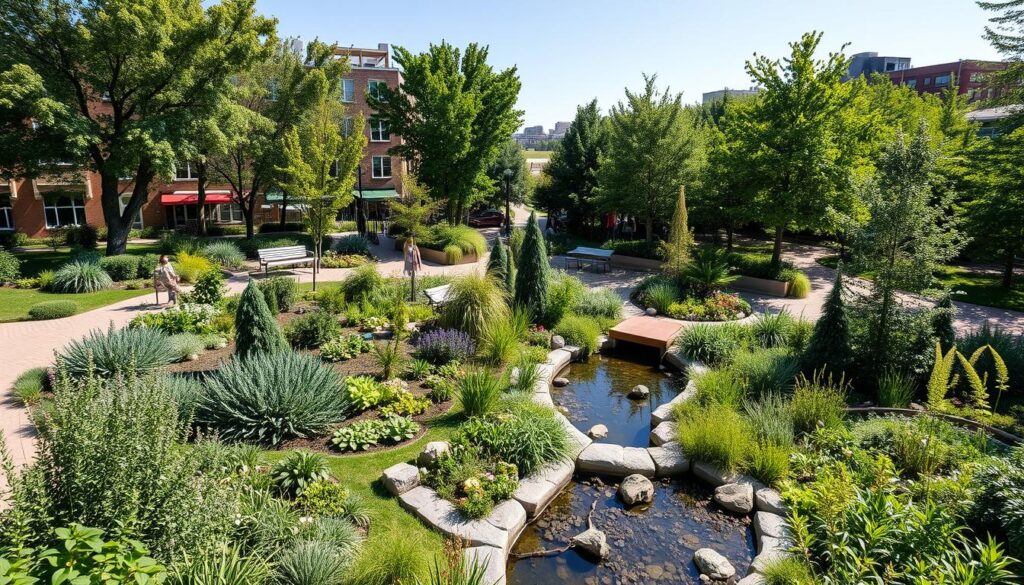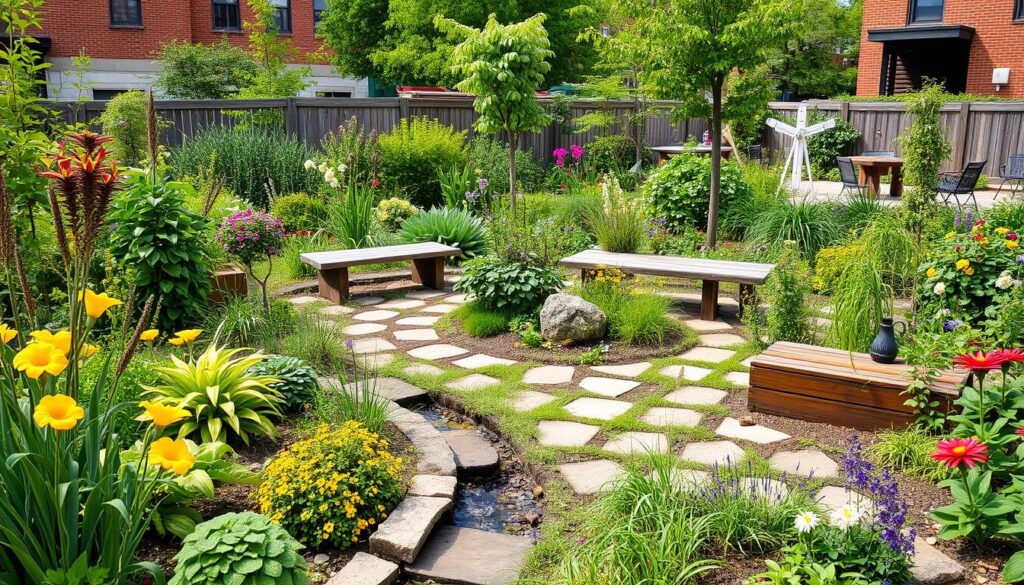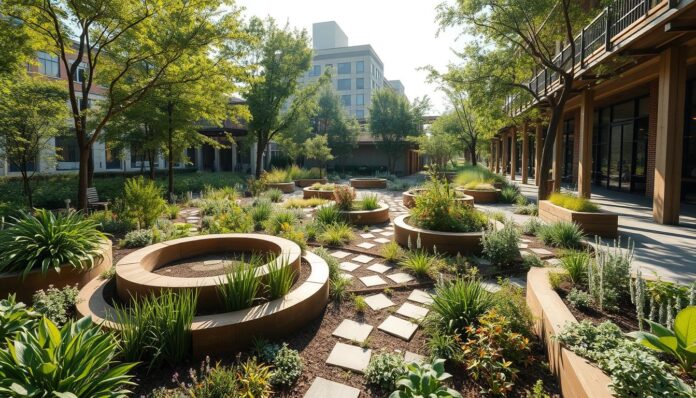Permaculture civic spaces are made to be green, self-sufficient, and healing. They create beautiful, useful public areas that bring people together. By using permaculture in civic design, we make sustainable urban design with community gardens. This improves life for everyone living there.
This design method has worked well in cities like Portland. There, people helped design public spaces that are lively and strong.
Permaculture is an old practice brought back 50 years ago by Bill Mollison and David Holmgren. It helps make community gardens and public areas thrive. For example, Tree Pittsburgh grows 45,000 tree and shrub seeds yearly. They’ve also given and planted 182 trees and berry bushes in over 18 places, like gardens and parks.
Key Takeaways
- Permaculture civic spaces are designed to be sustainable and community-driven
- Community gardens are an essential component of permaculture civic spaces
- Participatory design processes can lead to the creation of vibrant and resilient public spaces
- Permaculture principles can be applied to create thriving community gardens and public spaces
- Sustainable urban design is crucial for enhancing the overall quality of life for residents
- Permaculture education and design literacy are essential for increasing professional relevance and community engagement
Introduction to Permaculture Civic Spaces
Permaculture is a design system that focuses on creating sustainable environments. It’s used in civic spaces to make public areas beautiful, functional, and community-focused. Green infrastructure, like parks and eco-friendly spaces, is key to vibrant, sustainable areas.
Bill Mollison and David Holmgren brought permaculture back 50 years ago. Since then, it’s become popular in civic spaces. For example, Adelaide’s public parks now thrive thanks to permaculture.
- Environmental sustainability through the use of eco-friendly public spaces
- Enhanced community well-being through the creation of functional and aesthetically pleasing public areas
- Economic viability through the reduction of maintenance costs and the promotion of local economic growth
Permaculture in civic spaces leads to sustainable, thriving areas. Green infrastructure, parks, and eco-friendly spaces are crucial for this goal.
| Benefits of Permaculture Civic Spaces | Description |
|---|---|
| Environmental Sustainability | Through the use of eco-friendly public spaces |
| Enhanced Community Well-being | Through the creation of functional and aesthetically pleasing public areas |
| Economic Viability | Through the reduction of maintenance costs and the promotion of local economic growth |
Key Principles of Permaculture
Permaculture is a way to design sustainable environments. It focuses on observing and interacting with nature. This method helps create efficient, productive, and resilient systems. It’s great for urban agriculture, sustainable landscaping, and community engagement projects.
Observe and Interact
Understanding the environment is key in permaculture. We learn about the local climate, soil, and plants. This helps us design systems that work with nature, not against it.
By doing this, we can make urban agriculture systems that grow fresh food. They also reduce waste and encourage community engagement.
Catch and Store Energy
Catching and storing energy is another important principle. We use renewable sources like solar and wind power. We also use sustainable landscaping to cut down energy use.
This way, we depend less on non-renewable energy. It helps make urban agriculture practices sustainable and regenerative.

Produce No Waste
Permaculture aims to produce no waste. It designs systems that are closed-loop, where everything is reused. This reduces waste and promotes community engagement.
It also makes urban agriculture systems sustainable and regenerative. This principle applies to sustainable landscaping too, where materials are recycled to cut down waste.
The Benefits of Permaculture in Civic Spaces
Permaculture can make civic spaces better. It makes them sustainable, focused on the community, and good for the wallet. By adding community gardens and green infrastructure to public parks, cities can lessen their environmental impact. This also boosts the health and happiness of their people.
Some key perks of permaculture in civic areas are:
- Environmental sustainability: permaculture spaces cut down on waste, save energy, and boost biodiversity
- Enhanced community well-being: community gardens and parks offer chances for socializing, fun, and learning
- Economic viability: permaculture helps local economies grow and can raise property values
For instance, Portland has seen big economic wins from its permaculture public spaces. There’s been a jump in property values and local business activity. By using permaculture in public parks and community gardens, cities can build green, lively areas. These spaces are good for the planet and the people living there.
| Benefits of Permaculture | Environmental Sustainability | Community Well-being | Economic Viability |
|---|---|---|---|
| Reduced waste | Conserved energy | Social interaction | Increased property values |
| Promoted biodiversity | Reduced carbon emissions | Recreational opportunities | Local economic activity |
Case Studies of Successful Permaculture Civic Spaces
Permaculture can turn public spaces into mini-ecosystems. They offer food, homes for wildlife, and a link to nature. Cities worldwide have seen this success, creating eco-friendly public spaces. For instance, Detroit’s urban gardens use permaculture to feed local people.
In Portland, parks are designed with permaculture. They show how to make sustainable landscaping and green spaces. These examples prove permaculture can make civic areas lively and green, supporting urban agriculture and the environment.

- Rainwater collection systems
- Community gardens and urban farms
- Green infrastructure integration
- Educational programs and workshops
These examples show how permaculture can make community spaces better. They offer lessons for other cities to adopt.
| City | Project | Features |
|---|---|---|
| Detroit | Urban Gardens | Permaculture principles, community engagement, fresh produce |
| Portland | Community Parks | Sustainable landscaping, regenerative environments, urban agriculture |
Designing Effective Civic Spaces
Designing civic spaces requires thinking about community, environment, and sustainable design. Cities can make public areas beautiful, useful, and green. For example, using permaculture, like food forests, helps create diverse and self-sufficient ecosystems.
Understanding community needs is key. This means knowing the local culture and what the community wants. Designers can then make spaces that fit the community’s needs, boosting engagement and belonging.
Adding local culture to civic spaces is possible in many ways. Using native plants, saving historic buildings, and adding public art that shows the community’s identity are good ideas. Also, using permaculture helps by creating wildlife habitats and choosing eco-friendly materials.
Important things to think about when designing civic spaces include:
- Assessing community needs and preferences
- Incorporating local heritage and culture
- Encouraging biodiversity and sustainability
By keeping these points in mind, cities can make public areas that are good for everyone. These spaces will be functional, green, and help the community feel connected.
Practical Applications of Permaculture
Permaculture has many uses in civic areas, like sustainable landscaping and urban agriculture. It helps design community gardens that are both pretty and useful. By adding rainwater systems, pollinator gardens, and green spaces, cities can lessen their environmental impact. This also boosts community health.
Some key benefits of permaculture in public spaces include:
- Less water runoff and better water use
- More biodiversity and support for local species
- More community involvement and participation
- Easy access to fresh, healthy food
For instance, Portland has made community gardens and green spaces a big part of its parks. This shows how permaculture can turn public areas into lively, green spots. By using sustainable landscaping and urban agriculture, cities can make their environments healthier and stronger for everyone.

Community Engagement Strategies
Community engagement is key in creating and keeping up permaculture-designed civic spaces. It helps cities promote environmental stewardship and design sustainable urban design. This benefits both the environment and the community.
Effective strategies include workshops, educational programs, volunteer chances, and working together on designs. These methods educate people about permaculture and let them help design. This ensures the community’s needs and dreams are considered.
A study by Park People showed that many people spent more time in parks during the pandemic. Almost 40% said they visited parks twice as much. This shows how important community involvement is in urban planning and design. By focusing on community engagement and environmental stewardship, cities can make sustainable urban design that supports walkability, livability, and community happiness.
| Community Engagement Strategy | Benefits |
|---|---|
| Workshops and Educational Programs | Education on permaculture principles, community involvement in design process |
| Volunteer Opportunities | Community engagement, maintenance and upkeep of public areas |
| Collaborative Design Processes | Community involvement in design process, consideration of community needs and aspirations |
Challenges in Implementing Permaculture Civic Spaces
Starting permaculture civic spaces can face many hurdles. One big issue is the lack of sustainable urban design in current rules. This makes it hard to set up community gardens and green infrastructure projects.
Policy and Regulatory Barriers
Rules and laws can block the way for permaculture civic spaces. For instance, zoning laws might stop community gardens or green projects in some places.
Financial Constraints
Money is another big problem. The cost of using permaculture design, like food forests, is often too high. This makes it tough for communities to find the funds.
Community Resistance
Getting some community members on board can be hard. They might not see the value in permaculture civic spaces or be hesitant to change.
| Challenge | Description |
|---|---|
| Policy and Regulatory Barriers | Lack of sustainable urban design principles in existing policies and regulations |
| Financial Constraints | High cost of implementing permaculture design techniques |
| Community Resistance | Lack of understanding or resistance to change |
Best Practices for Maintenance and Care
Keeping permaculture-designed civic spaces in top shape is key. This means continuous learning and adaptation to keep the space green and community-focused. Working together, people can help maintain and enhance the area, supporting environmental stewardship and sustainable landscaping.
Regular community meetings are vital. They let people share knowledge, talk about problems, and plan for the future. These gatherings help build a strong community spirit and encourage everyone to care for the space. Also, using monitoring and evaluation techniques helps check if the design is working and makes changes if needed.
- Implementing a rotational grazing system to improve land health and sustainability
- Practicing zero-waste principles to reduce trash and food waste
- Integrating diverse plant and animal relationships to enhance ecosystem functions
By sticking to these best practices and focusing on community engagement, environmental stewardship, and sustainable landscaping, permaculture spaces can flourish. They offer many benefits for both people and the planet.
Tools and Resources for Civic Planners
Civic planners have many tools and resources to help them. They can use permaculture design manuals for guidance. Online workshops and webinars offer education and training. Inspirational documentaries and films motivate them to create sustainable spaces.
Permaculture design manuals are a great resource. They provide a detailed guide for sustainable urban design. Online workshops and webinars let planners learn from experts and share their knowledge.
Planners can also find inspiration in existing projects. For example, Portland’s community gardens and green infrastructure are models. By using these resources, planners can create spaces that are good for the environment, fair for everyone, and economically sound.
The Role of Technology in Permaculture
Technology is key in designing and caring for permaculture spaces. It helps communities create sustainable landscaping projects. These projects support urban agriculture and community gardens. They make public areas look better and bring people together.
Some examples of technology in permaculture are:
- GIS tools for mapping and planning
- Apps for community engagement and communication
- Social media for awareness campaigns and education
Technology helps permaculture projects grow stronger and more self-sufficient. As cities grow, the need for urban agriculture and community gardens will too. This makes technology in permaculture even more important.
Using technology in permaculture design makes systems better. They work more efficiently and help both people and the planet. We should keep finding new ways to mix technology and permaculture. This will help us build a greener, more vibrant world.
| Technology | Application in Permaculture |
|---|---|
| GIS Mapping | Design and planning of sustainable landscapes |
| Apps | Community engagement and communication |
| Social Media | Awareness campaigns and education |
Policy Frameworks Supporting Permaculture Initiatives
Cities are moving towards sustainable urban design. This shift helps grow community gardens and green infrastructure. Policy support is key to this growth.
Local Government Incentives
Local governments can offer incentives for permaculture adoption. They might give tax breaks or subsidies for community gardens and green infrastructure.
Grant Opportunities
Grants are vital for permaculture projects. Governments and groups fund initiatives in sustainable urban design and community gardens.
Zoning Regulations Adjustments
Zoning rules can be changed for permaculture spaces. This lets cities have community gardens and encourages green infrastructure in projects.
With these policies, cities can nurture permaculture. They support sustainable urban design, community gardens, and green infrastructure.
The Future of Permaculture Civic Spaces
Permaculture is growing, and its use in public areas is key for community engagement and environmental stewardship. It focuses on sustainable landscaping. This approach brings many benefits, like more biodiversity, cleaner air, and better community health.
Some exciting trends in permaculture public spaces include rainwater harvesting, pollinator gardens, and green infrastructure. These elements help protect the environment and teach people about it. They also bring communities together.
Permaculture public spaces are great for building community ties. They are designed to be welcoming and easy to access. This is vital in cities, where green areas are scarce and sustainable landscaping is essential.
Look at cities worldwide for examples of permaculture success. Detroit’s urban gardens and Portland’s community parks show what’s possible. These places turn public areas into vibrant ecosystems. They support environmental stewardship, community engagement, and sustainable landscaping.
| Permaculture Principle | Application in Civic Spaces |
|---|---|
| Observe and Interact | Community-led design and planning processes |
| Catch and Store Energy | Rainwater harvesting systems and green roofs |
| Produce No Waste | Composting programs and zero-waste initiatives |
Conclusion: The Path Forward
Looking at how permaculture can change civic spaces, we see a clear path. It’s all about working together and getting the community involved. This way, we can make public areas that are not just pretty but also useful and good for the planet.
Portland is a great example. They’ve used permaculture in their parks to make amazing community gardens. These efforts have made the city greener and brought people closer together.
Creating a sustainable city is a team effort. It needs the help of city planners, community groups, and citizens. By using permaculture, we can make our public spaces better for everyone and for nature.

